|
but still a family business 19th Century-style managing partnership with full liability in the event of failure irks some investors as outdated, but arguably fosters long-term stability and keeps corporate raiders at bay…
NOW the world’s largest tyre maker, Michelin designs, manufactures and sells tyres for every type of vehicle from aircraft, cars, bicycles, earthmovers, agricultural equipment, heavy trucks and motorcycles to the space shuttle. It is also prominent in motor racing and rallying and motor cycle sports. The Michelins’ fascination with rubber goes back 1832 when cousins Aristide Barbier and Édouard Daubrée set up a small farm equipment and pump making business in Clermont-Ferrand. Daubrée married Elizabeth Pugh Barker, a niece of Scottish chemist Charles Macintosh who had discovered that India rubber dissolved in coal-tar naphtha, and thus invented the raincoat named after him. POTENTIAL Elizabeth had a penchant for making rubber balls for her children to play with. And so the partners came to recognise the potential in using vulcanised rubber to make seals, belts, valves and other parts. Barbier’s grandsons – André Michelin and his younger brother Édouard – took over the business in 1886. They re-named it Michelin et Cie in 1889, and that same year Édouard discovered that air-filled – pneumatic – tyres made bicycling more comfortable. The trouble was those early tyres were glued onto the rims, and it took hours to change them. Édouard resolved this in 1891 when he came up with a detachable tyre, reducing the change time to only 15 minutes. The next 15 years saw increasing numbers of cars and aircraft and, to promote their products, the brothers sponsored long-distance car, cycle and aero races. They also introduced the Guide Michelin and the first road maps to encourage car travel. By 1908 the company had established operations in England, Italy and New Jersey, USA, and over the years the Michelin history was to be one of innovation. It introduced the detachable rim and spare tyre in 1906, the tubeless tyre in 1930, the treaded tyre in 1934 and the radial tyre in 1946. Today the Michelin group owns 74 factories in 19 countries, and has six rubber plantations in Brazil and Nigeria. It makes 36,000 products, builds more than 840,000 tyres a day, and sells in more than 170 countries – as widespread as China, Brazil, the United States, Germany and Russia. When Michelin went on the take-over trail in the United States, it was after companies with similarly long heritages. In 1990, it completed acquisition of Uniroyal-Goodrich Tire Company Inc, a combination of businesses that began as the United States Rubber Company in 1892 and as BF Goodrich in 1870. This gave Michelin the critical mass to assure its future in North America and helped its ascent up the world league. GROWTH Despite such a major acquisition, Michelin lacked a clear organisation blueprint until the early 1990s. Formal job titles were virtually unheard of and, in perhaps another reflection of the gentlemanly 19th Century set-up, some managers felt that to even mention marketing was ‘almost impolite’. In the late 1990s, despite its growth, Michelin continued to lose ground to Bridgestone, which had taken over Firestone, a major supplier to Ford in the US. But this was later to prove a double-edged sword for the Japanese company. This was the situation when François Michelin decided to retire and make way for his son Édouard. By 2001 Michelin was enjoying steady growth, when its chance to snatch market leadership came. Accidents involving Ford SUVs were blamed on tyre failures, and as a result Firestone’s sales plummeted – and with them down went Bridgestone’s market share. AFTER-MARKET The mood at Michelin was again buoyant in early 2003. Despite a stagnant world market and rocketing raw material costs – up 40 per cent between 2000 and 2004 – it had almost doubled its net profits over the previous year. It had even broken into the Asian market – long considered its Achilles’ heel – with a joint-venture in India and two major acquisitions in China. Michelin participates primarily in the after-market – rather than original equipment – with 70 per cent of its sales represented by replacement tyres for cars and light and heavy trucks. It enjoys a fifth of the world market – 53 per cent of its business is done in Europe, 33 per cent in North America, and 14 per cent in Asia, South America, the Middle-East and Africa. The past two decades have seen considerable consolidation in the tyre industry: Dunlop aligned with Goodyear, Firestone with Bridgestone, General with Continental, Armstrong with Pirelli, and Uniroyal and Goodrich with Michelin. Now three global players dominate more than half the market – Michelin has 19.4 per cent, Bridgestone 18.2 per cent and Goodyear 16.5 per cent. Eight mid-size competitors – Continental, Pirelli, Sumitomo, Yokohama, Cooper, Hankook, Kumho and Toyo – share a further 25 per cent, and local or niche companies account for the remaining 21 per cent. Even to this day, members of the extended Michelin family retain a degree of control remarkable for such a significant business. About 500 of them are thought to share a substantial – but constitutionally undisclosed – stake in the group, and their collective will has been exercised through Michelin’s command structure, which affords extensive powers in exchange for unlimited liability for any losses. Compagnie Générale des Etablissements Michelin, the parent company, was incorporated 1889 as Michelin et Cie, a partnership limited by shares – société en commandite par actions. SAFEGUARD Michelin says this original model, attuned to modern corporate governance standards, favours implementation of long-term strategies by a stable, committed management team, monitored by an independent supervisory board. And, since all of the shares are registered, the company is able to maintain close contact with each of its shareholders. Michelin has always been led by a team of managing partners, who have previously held key operational posts in the company. Accountable to the shareholders for their decisions, they are assisted by a 10-member executive council that meets monthly. The managing partners are answerable for the company’s full liabilities in the event of failure. Few businesses offer shareholders such a guarantee that management decisions are in their mid- to long-term interests. A safeguard against copping-out if the going gets tough is that managing partners may not relinquish their status as general partners without prior approval of an extraordinary shareholders’ meeting. So they are bound to face the consequences of their decisions in the long term. Managing partners are entitled to a statutory share of the company’s profits, but not to salaries or non-cash and retirement benefits This set-up is disliked other investors, who point out that that most other major French family firms have long since adopted société anonyme – limited liability – arrangements l |
||||||
|
THE SUCCESSION |
||||||
|
Born at Annecy in eastern France in 1944, Michel graduated from the Political Institute of Paris in 1967 and has a degree from the Law University of Paris. Married with three children, he was responsible for site, divisional and group risk management for the Aussedat-Rey company, a division of the International Paper Group, from 1973 to 1982. He headed an operational unit from 1982 to 1987, and was joint-chairman of this company from 1987 to 1996. Rollier joined Michelin in 1996, and was appointed director of the legal department and financial operations in 1997. He took on additional responsibilities as director of plans, results and risk management and also joined Michelin’s group executive council in 1998. The following year he became the group’s chief financial officer. In early 2005, Édouard Michelin and René Zingraff invited Michel Rollier to join them as a joint-managing partner, and his appointment was subsequently ratified by shareholders at the AGM l |
||||||
|
recognised the world over |
||||||
|
IN 2004, Édouard created something of a commotion when he proposed dispensing with the services of the company’s iconic mascot – Bibendum – in marketing the Michelin brand. However stockholders quite understandably voted against this notion. One of the world’s oldest and best recognised trademarks, Bibendum was after all synonymous with the company’s genius, representing it in 170 countries. The Michelin Man was created in 1898 when joint-founder Édouard Michelin, a trained artist, remarked that a stack of tyres would resemble a man if it had arms. His brother André commissioned one O’Galop, pseudonym of the French painter Marius Rossillon, who transformed the concept into reality. O’Galop’s poster showed Bibendum proposing the toast ‘Nunc est bibendum’ from Horace’s Odes – Latin for ‘Now is the time to drink’ or ‘Cheers!’ – to his scrawny competitors with a glass full of road hazards. The title and tag read: ‘À vôtre santé. Le pneu Michelin boit l’obstacle’ – ‘Cheers! The Michelin tyre soaks up obstacles’. It is unclear when the Bibendum name was adopted but, at the latest, it was in 1908 when Michelin commissioned Curnonsky, nom de plume of gastronomic writer Maurice Sailland, to pen a newspaper column signed ‘Bibendum’. The Bibendum figure has in some ways become synonymous with obesity or wearing comically bulky clothing – ‘wrapped up warm like a Michelin Man’ – and in Spain, 'michelín' has come to mean ‘tyres’ or rolls of fat around the waist. O’Galop’s original logo was based on bicycle tyres, wore spectacles and smoked a cigar. But Bibendum’s shape has altered over the years. By the 1980s, he was portrayed as a running ‘Bib’. An even more athletic, slimmer ‘Bib’ with better vision appeared in 1998, reflecting lower-profile tyres, and he had long since given up smoking. Bibendum even made a brief guest appearance as the chariot wheel-dealer in a number of translations – including English – of the Asterix in Switzerland cartoon story book. Though the original French version used the Gaulish warrior mascot of French fuel company Antar-Pètroles de l’Aquitaine, merged with Elf in 1976 to form Société National Elf Aquitaine l |
||||||
|
||||||
|
FORMULA 1: PROFOUND DIFFERENCES |
||||||
|
In late 1999, Michelin declared its intention to return to F1 in 2001, and prepared for this with two test drivers covering 10,000 km while evaluating 3,000 tyres at various circuits. The yield from the first season was four wins for BMW Williams driven by Ralf Schumacher and Juan Pablo Montoya. Pickings were thinner in 2002, but the following year Michelin runners moved up a gear, winning seven of 16 races, and Kimi Räikkönen and McLaren-Mercedes came within an ace of depriving Michael Schumacher of the drivers’ title. Ferrari dominance continued in 2004, though Michelin’s partner teams Williams, McLaren and Renault managed one victory apiece. However, everything came together in 2005, enabling Michelin and its seven teams to chalk up a dazzling array of statistics. Fernando Alonso became the youngest ever world champion, and Renault won the constructors’ championship. Michelin runners won 18 of the 19 races, and scored 619 of the available 741 points. Michelin’s 2005 tally also included World Rally Championship wins for Sébastien Loeb and Citröen, a Paris-Dakar victory for Bruno Saby and Volkswagen, and Audi’s diesel-powered success in the Le Mans 24-hour race. Yet, though Alonso and Renault were poised to repeat their double – even if hotly contested by Michael Schumacher and Ferrari – Michelin had already decided to quit F1 at the end of 2006. This was due partly to dissatisfaction with the handling of the tyre fiasco at Indianapolis last June and also with the rules. ‘This decision is the result of profound differences’, Édouard Michelin said, ‘between Michelin’s long-standing sporting philosophy and the way Formula 1 is managed by the regulatory authorities, which no longer provide a clear and sustainable environment to justify long-term investments’ l |
||||||
|
|
||||||
|
SEEKING SUSTAINABILITY |
||||||
|
This first event involved a rally from Clermont-Ferrand to the Champs-Elysées in Paris, to demonstrate that clean technology really worked. The second Challenge in 2000 was also based on Clermont Ferrand, but thereafter it moved further afield. In 2001, the Challenge was centred on Fontana near Los Angeles, California, chosen because of the state’s ultra-stringent emissions regulations. It attracted the world’s eight largest car makers and representation from leading universities. By 2002, with natural gas and electric cars entering the fray, the event began in Heidelberg, Germany, and made a call at the European Parliament in Strasbourg en route for Paris. The Challenge returned to California in 2003, this time to Sonoma in wine country near San Francisco. The contest attracted 100 vehicles from 14 manufacturers from America, Europe and Japan. The line-up included electric and hydrogen-fuelled cars, as well as trucks and buses for the first time. These were independently evaluated under real driving conditions, not in laboratories. And, to keep contestants’ feet on the ground, the scoring system embraced factors such as style, speed, silence, impact safety, emissions and fuel economy. In 2004, the Challenge moved to Shanghai, China, an awakening giant and thus very relevant to the global clean air question. The attendance included 500 journalists and 2,000 VIPs – politicians and government officials from China, the USA, France, the UK and the EU, as well as motor industry executives and representatives of international bodies such as the United Nations, the World Bank and the World Health Organisation. themes The event was dominated by hydrogen, biofuel and hybrid vehicles. Timed to coincide with a gathering of the World Business Council for Sustainable Development in Nagoya, the 2005 Challenge involved 51 vehicles in a 177-km run from Kyoto to the World Expo site in Aichi. This time, the focus was on safety with participation of ASVs – Advanced Safety Vehicles – and ITSs – Intelligent Transportation Systems. Dedicated to Édouard’s memory, the 2006 event was based in Paris, with a finalé at the Eiffel Tower. There were three main themes: the energy challenge for road transport; advanced technologies to support increasingly urban road mobility; technology and road safety. The tyre industry is meeting the challenge of climate change, says Michelin. It claims that, since it first launched its ‘green’ Energy tyres in 1992, these have saved 23 million tonnes of CO2 emissions and 9.5 billion litres of fuel. It believes substantial further savings are available through better tyre maintenance – especially regular pressure checks – to minimise rolling resistance, reduce wear and improve safety. Michelin says it manufactures a number of tyres shown to last at least 25 per cent longer than other brands, and this can save further energy in manufacture and disposal. ‘If all the 110 million cars in Europe were running on green tyres, we could save three billion litres of fuel each year and reduce the CO2 emissions by 7.5 million tonnes at the same time,’ says the company’s UK and Ireland communications chief Peter Snelling. ‘If the road-haulage industry fitted Michelin Energy 2 truck tyres they would save 6 per cent of the fuel consumed in road haulage in Europe, and that is easily enough to pay for the tyres.’ Michelin claims it was first to introduce silica into its rubber compounds to decrease rolling resistance, which accounts for 20 per cent of a car’s fuel consumption during forward motion. The proportion rises to 30 per cent in multi-wheel trucks. Michelin’s Proxima concept tyre is 20 per cent lighter and has 25 per cent less rolling resistance – benefits that will feed into production tyres over the next 10 years l |
||||||
|
GUIDING HAND |
||||||
|
André Michelin published his first guide to France in 1900, printing 35,000 copies, and followed through with a first road map in 1910. His intention was to promote motoring – and thus tyre sales – by helping drivers get their cars maintained, charge a battery, find decent lodgings, and eat well while touring. Addresses of petrol stations, garages, tyre stockists and even public lavatories were included. Hotels were rated according to price until 1907. Five rating categories – covering general levels of comfort, amenities, meal prices and room sizes – were introduced in 1908, and a sixth category – where one could ‘lunch and dine adequately’ – appeared in 1909. By 1914, more than 80,000 guides were being printed annually, and their use by French troops was widespread during World War I. While preparing for the D-Day landings in Normandy in 1944, Allied chiefs of staff were worried that German destruction of road signs might hamper progress through French towns. So, with permission from Michelin’s Paris management, the 1939 guide was reproduced unabridged. Stamped ‘For official use only’, copies were distributed to officers to give them the benefit of hundreds of detailed city and town maps. stars Originally in a blue cover, the guide was distributed free until 1920. A cover price was introduced after a pile of guides was found propping up a garage workbench, suggesting the public placed no real value on free gifts. A star to denote ‘fine cuisine’ was introduced in 1926. Between 1931 – when the cover turned red – and 1933 two and three stars were added to rate ‘the flower of French cooking’. To this day, the guides employ anonymous inspectors and do not charge for entries – unlike some rivals which are in effect financed by advertising. Inevitably, the guides are no strangers to controversy. One bone of contention is that Michelin inspectors’ secret criteria, mean even the most experienced chefs don’t really know what they are aiming for. Another is the accusation that Michelin’s rating system is too biased towards French cuisine, an issue that came to the fore with publication of the first New York City red guide in 2005. The New York Times reported that restaurants serving a French menu accounted for more than half of those awarded two or three stars, and that many otherwise highly-rated establishments received none. Introduction of the now very comprehensive ViaMichelin web site marked the guides’ centenary in 2000. It offers a route planner, weather and traffic information, and a hotel and restaurant search engine. Red guides cover Austria, the Benelux, France, Great Britain and Ireland, Italy, Spain and Portugal, and now New York City. They are offered in the English, French, Dutch, German, Italian, Japanese, Portuguese and Spanish languages. The company also publishes green tourist guides for every French region and many countries, regions and cities outside France, and these too appear in a variety of languages. Michelin now sells almost 20 million maps, atlases, travel guides and hotel and restaurant guides in more than 70 countries world-wide every year l Copyright © 2006 by Anthony Howard for Vehicle Engineer |
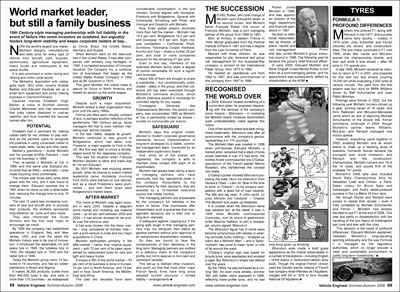
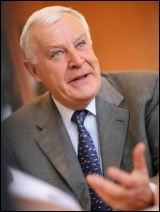 MICHEL Rollier (pictured left), who took charge of
Michelin upon Édouard’s death, is his second cousin. And Michel’s father
François Rollier, first cousin of François Michelin, was a joint managing
partner of the group from 1966 to 1991.
MICHEL Rollier (pictured left), who took charge of
Michelin upon Édouard’s death, is his second cousin. And Michel’s father
François Rollier, first cousin of François Michelin, was a joint managing
partner of the group from 1966 to 1991.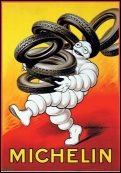
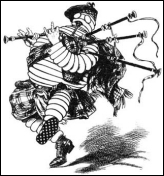
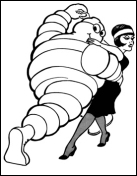
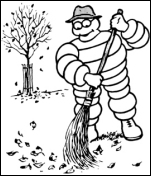
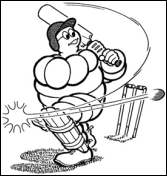
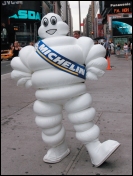
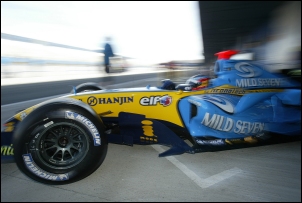 MICHELIN
first entered F1 racing with Renault in mid-1977, and success came
fairly quickly – notably in 1979 when Jody
Scheckter and Ferrari clinched the drivers’ and
constructors’ titles. The tyre maker continued in F1 until 1984, when
Niki Lauda and McLaren scored the championship double, and then quit
while it was ahead – after 59 wins in 112 grands prix.
MICHELIN
first entered F1 racing with Renault in mid-1977, and success came
fairly quickly – notably in 1979 when Jody
Scheckter and Ferrari clinched the drivers’ and
constructors’ titles. The tyre maker continued in F1 until 1984, when
Niki Lauda and McLaren scored the championship double, and then quit
while it was ahead – after 59 wins in 112 grands prix.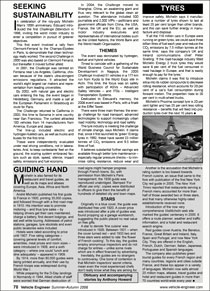
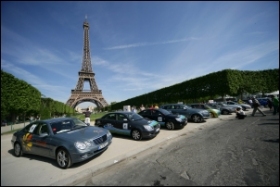 IN celebration of the roly-poly
Michelin Man’s 100th anniversary, Édouard introduced the first
Challenge Bibendum in 1998, inviting the world motor industry to enter
a competition in pursuit of greener objectives.
IN celebration of the roly-poly
Michelin Man’s 100th anniversary, Édouard introduced the first
Challenge Bibendum in 1998, inviting the world motor industry to enter
a competition in pursuit of greener objectives. 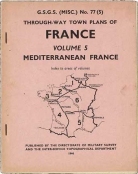 M
M